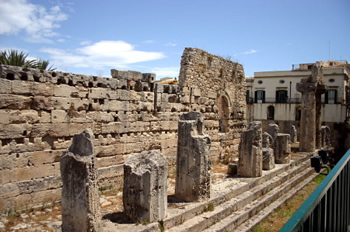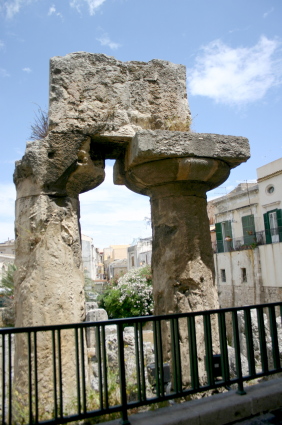
The Temple of Apollo in Syracuse
At the center of Largo XXV Luglio in Ortigia
one can see the remains of the oldest Doric temple of the Magna
Graecia available to us, the Temple of Apollo, dating
from the 6th century B.C.
 |
| The side of the Temple of Apollo miraculously survived for millennia. |
As with many ancient monuments, this one is located on a much lower level than that of the square around it, owing to the accumulation of debris over the centuries, which raised the ground level.
Until 1860 the temple had been untraceable, since it had been transformed into a Byzantine church, later converted into a mosque (an inscription in Arabic remains), then returned to the church during the Norman period (there is a lancet window in the cell wall, which shows the level of the soil in the 12th century), and then deconsecrated, partially demolished and turned into a barracks during the Spanish period.
Only in 1860, notably, was something found hiding in what was then the barracks, and only between 1938 and 1942 the remains of the temple were freed from the modern additions and at last excavated.
The building is conserved in good condition,
and, despite having lost most of its columns, still exhibits a long stretch
of wall.
In one corner, two columns and a fragment
of an architrave give an idea of the imposing size of the ancient building.
The temple was, as was everything from the same period, covered by decorative, colored terracotta, the remains of which are now on display at the Archaeological Museum “Paolo Orsi”.
How to Reach the Temple of Apollo from
the Algilà
Ortigia Charme Hotel.
The Temple of Apollo in Syracuse is located
a few hundred meters / feet from the Hotel
Algilà in Largo XXV Luglio in Ortigia. One is advised, therefore,
to make the journey on foot.
 |
| Two Doric columns of the Temple of Apollo in Syracuse are the only surviving ones. |
Visitor Information
At the moment, in fact, a visit to the
remains of the temple is not permitted.
However, the ruins are surrounded by a
square, separated from it by a simple railing, and can be easily admired
from the outside.
There are no major architectural barriers
around the fence.
Back to TOURISM IN SYRACUSE, SICILY